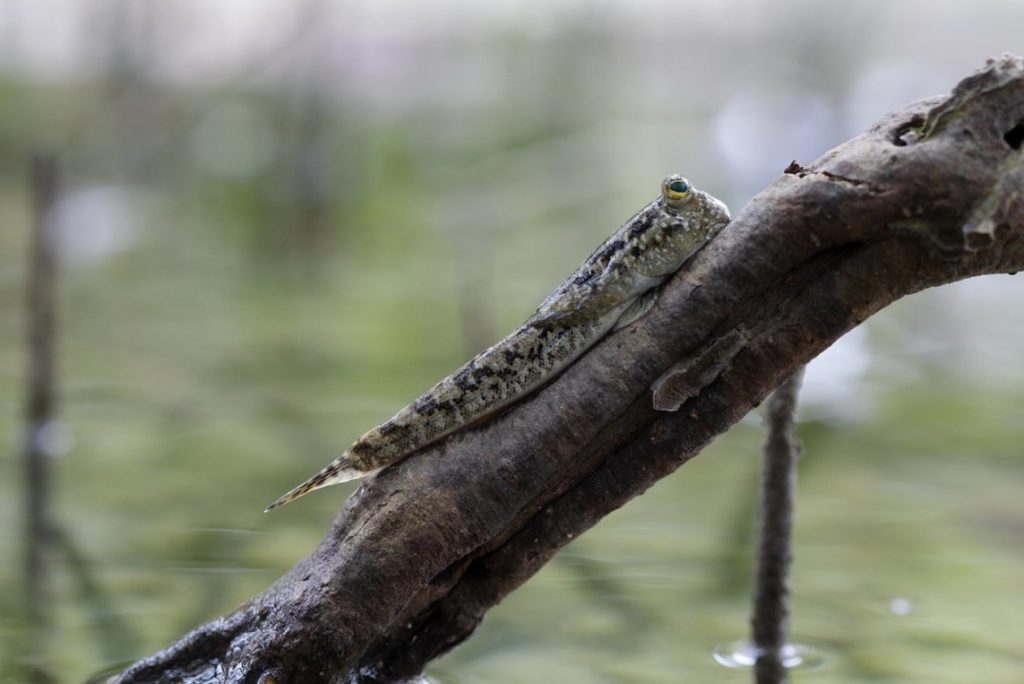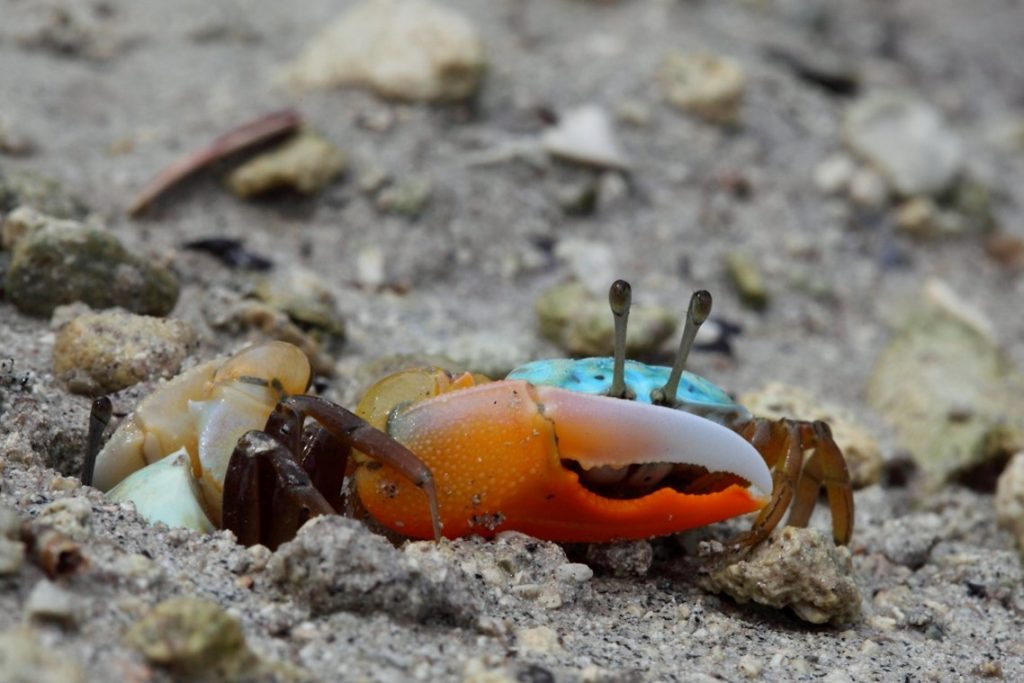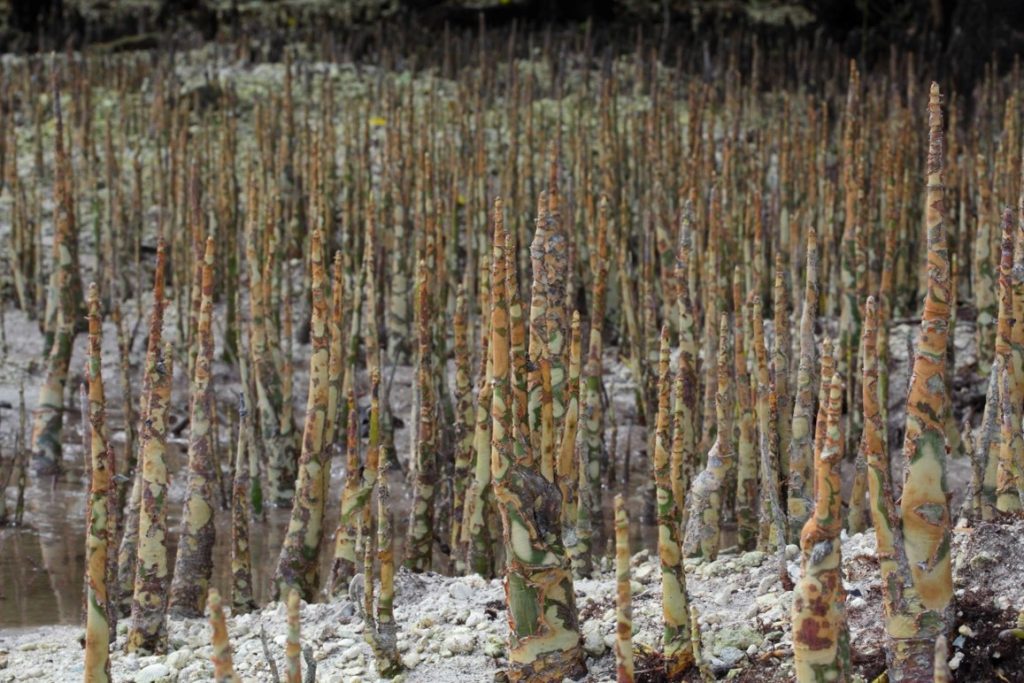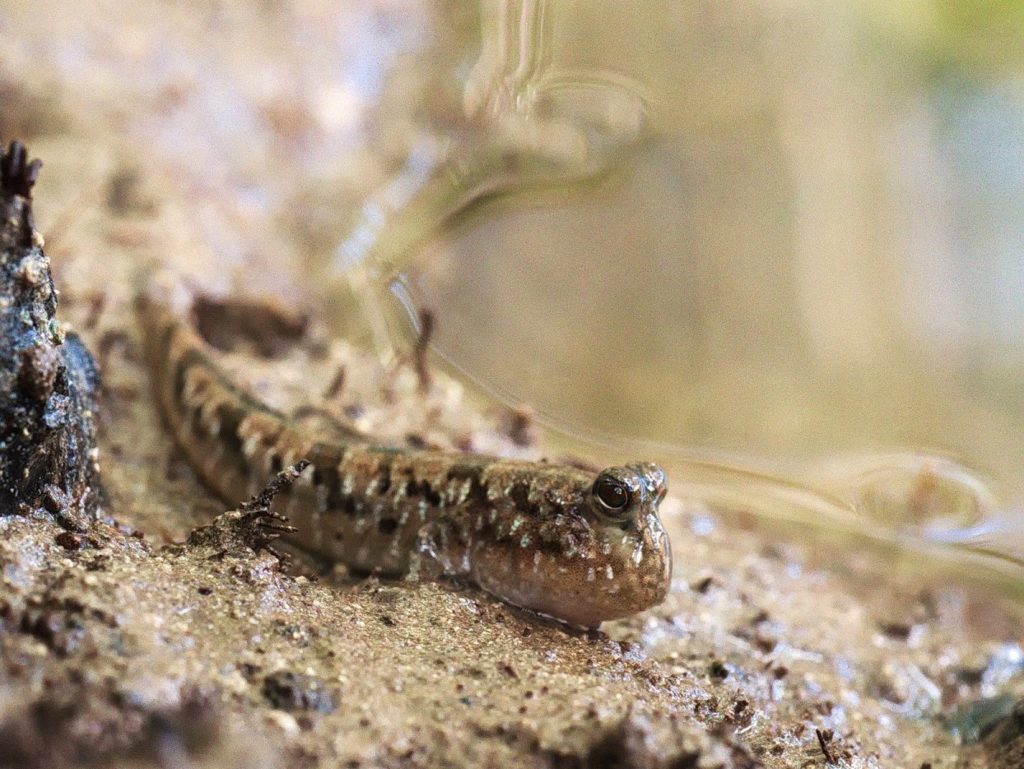In a recent article we looked at the evolutionary adaptations mudskippers have undergone in their transition towards an amphibious lifestyle. The second part of this series looks in depth at their behavior and their mangrove homes. The notion that fish are dumb, mindless creatures might be held by parts of the general public, but certainly not by aquarium hobbyists and scuba divers who spend a lot of time observing fishes. Mudskippers are an excellent counterpoint to the notion of the dumb fish, since they show surprisingly complex behavior.
Talk to Me, Mudskipper
Mudskipper densities in their natural environments can be quite high, and as a consequence, the individual fish have to deal with their neighbors. Mudskipper (Boleophthalmus boddarti) populations on mudflats in Kuwait, along the delta of the Shatt-Al Arab, build miniature mud walls to delineate their territories. In some areas the small-walled mudskipper territories span wide expanses of the mudflats, occupying up to 80 meter-wide bands running parallel to the river. From afar, these bands look like a vast metropolitan suburb seen from an airplane window.

Mudskipper, Periophthalmus sp., on a mangrove root. Cebu, Philippines.

A mangrove crab: Mudskippers share their mangrove habitats with a variety of invertebrates.
Not all mudskippers in these dense aggregations own walled real estate; smaller fish roam around in the periphery and are chased away by home-owners when they get onto someone’s plot.
The body language of the two fish in conflict with each other is varied: opening the mouth to a wide gape to show one’s size is combined with raising of the head, as well as flexing open the dorsal fins. The latter is a strategy for showing off also frequently employed in marine gobies. If all else fails, one goby might attack and bite the opponent. In the Boleophthalmus boddarti observed in Kuwait there wasn’t any obvious sex difference in the agonistic encounters.
Communication between mudskippers is not restricted to body language. Sound production is actually not a rarity among fishes. In contrast to land vertebrates, where sounds are typically produced by expulsing air out of the lungs, sound production mechanisms vary in fishes. Damselfish compress their swim bladders to make brief, threatening noises; in contrast it seems that gobies make noise by pushing water out of their gill covers.
Mudskippers have maintained this general goby-sound-producing-system, and use it to communicate when on land. The mudskipper Periophthalmodon septemradiatus makes individualized sounds – each fish sounds a tad different, just as human voices differ between individuals. Likely, this helps the fish to distinguish each other, and act according to the conspecific’s place in the hierarchy. The sound itself is a wild chirp, followed by a short series of brief clicks. Seemingly the sound waves travel via air, but also along the wet mud the mudskippers perch on.

A mudskipper in front of branching mangrove roots, an excellent hiding place from predators in search of a tasty amphibious goby.

Mangrove aerial roots stick out to provide the plants with a possibility of maintaining gas-exchange, which would be impossible through the partially anaerobic mud they grow in. Cebu, Philippines.
Burrows
Building burrows is a common skill among the gobies. Sand-living gobies of the genus Valenciennea construct underground burrows, working in mated pairs, excavating the sand mouthful after mouthful. The shrimp gobies have outsourced burrow-building to alpheid shrimps – probably a sign of even higher intelligence to get someone else to do the hard work. The mudskippers also build burrows, and they face additional challenges, since the rising and falling tides will alter the water level in their homes. At times, an air pocket remains in mudskipper burrows even at high tides.
The mudskipper burrows don’t just act as refuges from hungry predators, as they do in the case of marine gobies. These burrows also provide much-needed protection from the elements, such as the scorching Arabic desert sun in the case of the aforementioned Boleophthalmus boddarti in Kuwait. These fish routinely spend several hours every day underground to escape the desiccating heat. Mudskippers also frequently wait out high tides in their burrows.
Mangroves
While mudskippers also live in mudflats and along river deltas, the most charismatic ecosystem which they populate are the mangroves. These coastal forests are unique in several ways: their highly branched, three-dimensional root systems located above the ground can provide great hiding grounds for multiple small critters. Just as in coral reefs, complex three-dimensional structure of a habitat enhances biodiversity.
The mangrove mud is also has interesting chemical properties. Due to its high density, lack of mixing and rich content of organic materials, most of the mangrove mud except the very upper layer is devoid of oxygen (it’s anaerobic). The anerobic decomposition of organic matter in this type of mud doesn’t move all the way to releasing carbon dioxide as an end-product into the atmosphere; a part of the organic material remains buried, unable to decompose further in the absence of oxygen. Hence, mangrove soil stores an unusually high amount of carbon per hectare, a property highly valued in these times of excessive carbon emissions by human civilization. Even though it’s warranted, protecting mud might not be the easiest sell for an environmentalist; maybe the cute mudskippers can serve as the poster children for mangrove protection?
Any aquarium hobbyist hoping to keep happy mangrove-living mudskippers should try to replicate the type of mud as well as the labyrinth-like root system above ground. Mud can be obtained from intact coastal areas, and if needed cleaned with a diluted hydrogen peroxide solution. Artificial mud can be mixed from clay and sand at fine grain sizes; the aquarium keeper who is motivated to bring mudskippers to his or her home after reading these articles on reefs.com should consult the technical literature for a detailed how-to about the mud.

Life on the water’s edge.

A mudskipper, having taken a few steps onto land.
Many tropical and subtropical countries around the world have lost large fractions of their mangrove forests in the last few decades. Coastal real estate is highly valued for residential use, and for establishing shrimp and fish aquaculture ponds. In the Philippines, for example, according to the best available estimates less than a quarter of the mangroves which existed in 1918 remain today. This is a tragedy in terms of lost capability of carbon capture, and highly unfortunate due to the loss of habitat for an amazing fauna – none the least of which are the mudskippers.
References:
Budi, A. S., Widiyani, T., & Budiharjo, A. (2018, August). Daily behavior of the mudskippers at Wonorejo Mangrove Forest Surabaya. In AIP Conference Proceedings (Vol. 2002, No. 1). AIP Publishing.
Clayton, D. A., & Vaughan, T. C. (1988). Ethogram of Boleophthalmus boddarti(Pallas)(Teleostei, Gobiidae), a mudskipper found on the mudflats of Kuwait. J. UNIV. KUWAIT(SCI.)., 15(1), 115-140.
Polgar, G., Malavasi, S., Cipolato, G., Georgalas, V., Clack, J. A., & Torricelli, P. (2011). Acoustic communication at the water’s edge: evolutionary insights from a mudskipper. PLoS One, 6(6), e21434.
Primavera, J. H. (2004). Philippine mangroves: status, threats and sustainable development. Mangrove Management and Conservation: Present and Future, Bravo 1996, 192–207.










0 Comments